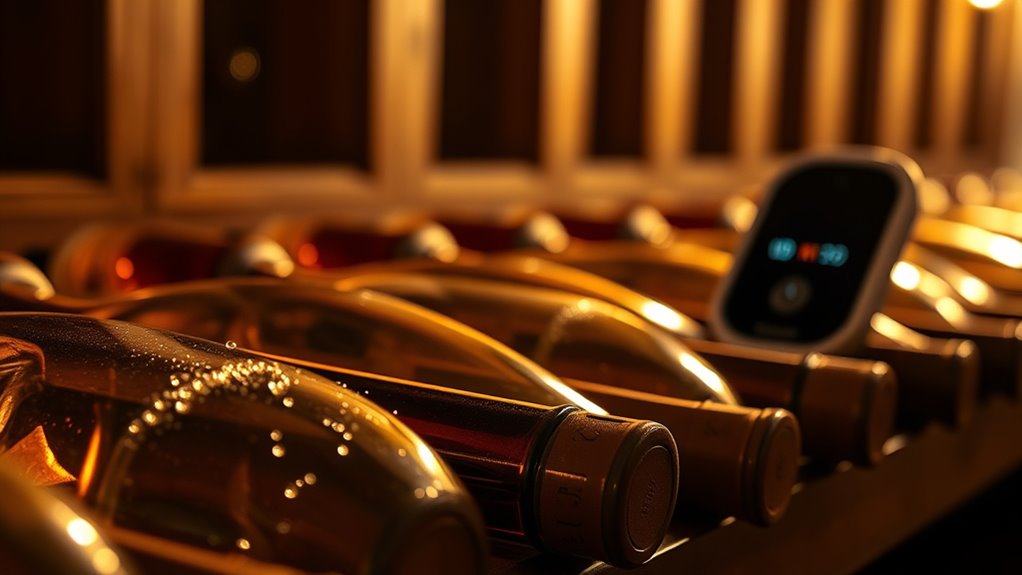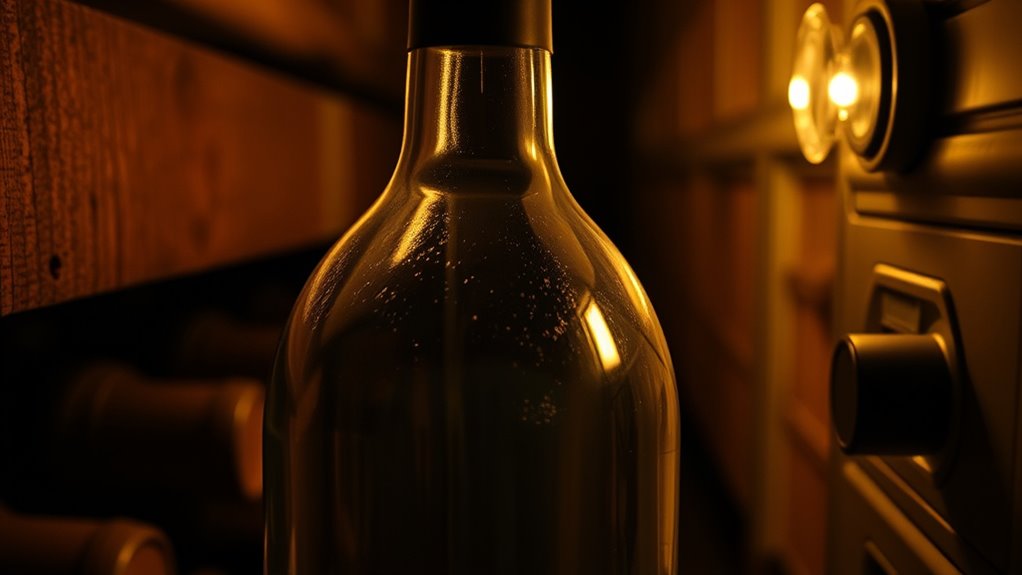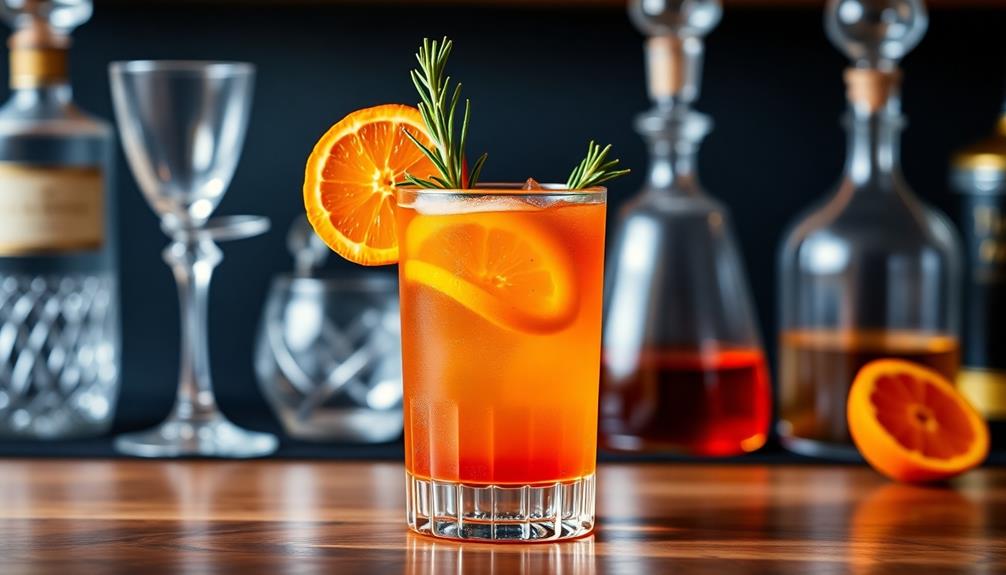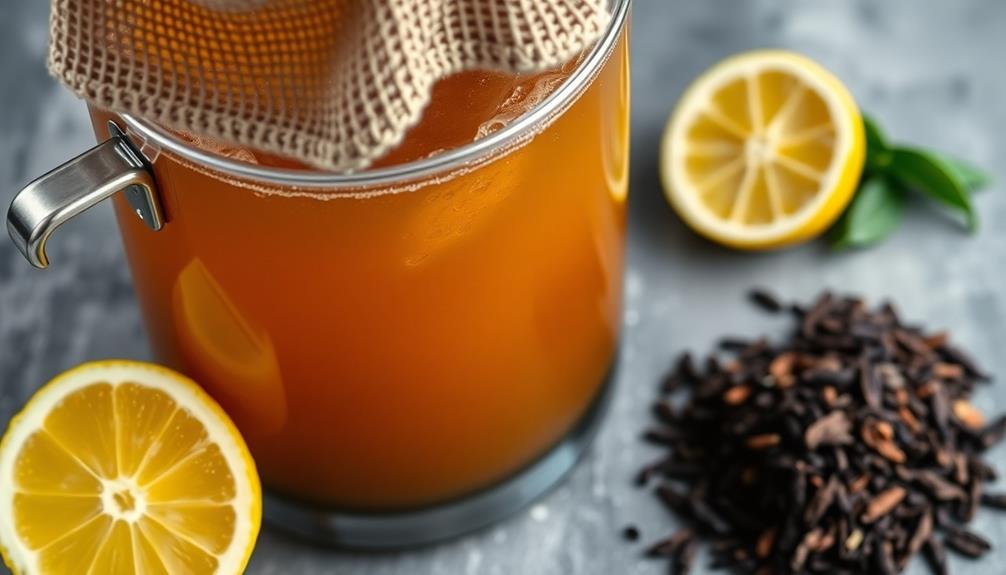To avoid premature oxidation and preserve your wine’s quality, control how much oxygen it’s exposed to during storage. Store bottles in a cool, dark place with steady temperatures, and keep corks moist by storing them horizontally. Natural corks allow small oxygen exchange, which can help wines age gracefully, but too much oxygen causes spoilage. Proper storage conditions and monitoring signs of oxidation can keep your wine flavorful longer—continue, and you’ll discover more tips for perfect preservation.
Key Takeaways
- Store wine in a cool, dark, consistent temperature environment (55-58°F) to slow oxidation processes.
- Use proper bottle closures like natural corks or screw caps to control oxygen ingress.
- Store bottles horizontally to keep corks moist and maintain a tight seal against oxygen entry.
- Avoid temperature fluctuations and direct sunlight, which accelerate oxidation and spoilage.
- Regularly monitor for signs of oxidation, such as dull color and dull taste, to prevent premature spoilage.

Oxygen plays a pivotal role in wine storage, influencing how your wine ages and its overall quality. While small amounts of oxygen are essential during the wine-making process, controlling its presence during storage is vital to prevent premature oxidation. When exposed to oxygen, the wine undergoes an oxidation process that can either enhance its flavor or, if unchecked, spoil it entirely. Understanding how oxygen impacts bottle aging helps you preserve your wine’s integrity and enjoy its full potential over time.
During bottle aging, minimal oxygen exposure is ideal. As wine matures, a tiny amount of oxygen slowly interacts with it through the cork or sealing material. This gentle exchange can help develop complex flavors and soften tannins, contributing to a more harmonious tasting experience. However, if oxygen seeps into the bottle in excess, it accelerates the oxidation process, causing the wine to lose its vibrant fruitiness and develop undesirable notes. This imbalance results in flat, dull flavors and a brownish hue, signaling that the wine has been prematurely oxidized and is no longer at its peak.
Minimal oxygen exposure during bottle aging enhances flavor and softness, but excess causes spoilage and dullness.
To avoid premature oxidation, you need to pay close attention to storage conditions. Keep your wine bottles in a cool, dark place with consistent temperature, ideally between 55-58°F (13-14°C). Fluctuations in temperature cause the wine to expand and contract, creating tiny gaps that allow oxygen to enter. High temperatures speed up the oxidation process, so avoid storing wine near heat sources or in direct sunlight. Additionally, store bottles horizontally to keep the cork moist; a dry cork can shrink or crack, providing an entry point for oxygen and hastening spoilage.
The type of bottle closure also plays a vital role. Natural corks allow a small amount of oxygen transfer, which can be beneficial for certain wines during bottle aging. However, if the cork is compromised or if you’re storing wine for an extended period, consider alternative closures like screw caps or synthetic corks designed to minimize oxygen ingress. These help maintain a more controlled environment, reducing the risk of premature oxidation. Properly ventilating storage areas and maintaining stable conditions are also important factors in preserving wine quality over time.
Finally, monitor your wine regularly. If you notice signs of oxidation—such as a sherry-like aroma, dull color, or flat taste—it’s a sign that oxygen has affected the wine. Proper storage and handling are your best defenses against the oxidation process ruining your wine prematurely. By understanding and managing oxygen exposure, you ensure your wine ages gracefully, preserving its quality and enjoyment for years to come. Recognizing oxygen control techniques can further enhance your wine storage practices and longevity. Implementing proper storage conditions can significantly extend the life and flavor profile of your wine collection.
Frequently Asked Questions
How Does Temperature Fluctuation Affect Oxygen’s Impact on Wine?
Temperature fluctuation can considerably impact how oxygen affects your wine. When temperatures vary, it disrupts temperature stability, causing the wine to expand and contract. This movement increases oxygen permeability through the bottle, exposing the wine to more oxygen. Over time, this accelerates premature oxidation, which can spoil the wine’s flavor and aroma. To protect your wine, keep storage conditions stable and avoid frequent temperature changes.
Can Oxygen Exposure Improve Wine Aging in Some Cases?
You might find that limited oxygen exposure can enhance wine aging, especially when using certain wine bottle closures designed as oxidation catalysts. Small amounts of oxygen can help develop complex flavors and soften tannins over time. However, too much exposure risks premature oxidation and spoilage. Proper closures regulate oxygen ingress, allowing controlled aging. So, in some cases, carefully managed oxygen exposure can improve wine’s complexity and aging potential.
What Are the Best Storage Containers to Prevent Oxygen Ingress?
Sometimes, the container you choose makes all the difference. You want storage that keeps oxygen out, so you should look for bottles with airtight seals and inert materials. These features prevent oxygen ingress, preserving the wine’s freshness and complexity. Glass bottles with good seals are ideal, as they’re inert and keep the environment stable. Proper storage containers guarantee your wine ages gracefully without premature oxidation, letting you enjoy every sip at its best.
How Do Different Wine Types React to Oxygen During Storage?
Different wine varietals react uniquely to oxygen during storage due to their oxygen sensitivity. Red wines, often more oxygen-sensitive, can develop complex flavors if exposed to controlled oxygen levels but spoil with excess. Whites and sparkling wines are typically less sensitive, so they require minimal oxygen exposure to maintain freshness. You should monitor each wine’s reaction closely, adjusting storage conditions to prevent premature oxidation and preserve their intended character.
Are There Any Natural Methods to Reduce Oxygen Contact in Bottles?
Did you know that natural barriers like cork stoppers and inert closures can reduce oxygen contact by up to 90%? To naturally lower oxygen exposure, you can choose bottles sealed with these closures, which act as inert barriers. Additionally, storing wine horizontally keeps the cork moist, creating a better seal. These methods help protect your wine from premature oxidation without added chemicals, ensuring it stays fresh and vibrant longer.
Conclusion
Remember, oxygen is like a double-edged sword—it can breathe life into your wine or usher in premature aging. Keep it at bay with proper storage, like a silent guardian preserving your bottles’ spirit. When you control oxygen’s dance, your wine remains vibrant, a symphony of flavors waiting to be savored. So, handle with care, and let your wine’s story unfold gracefully, free from the shadow of premature oxidation.









